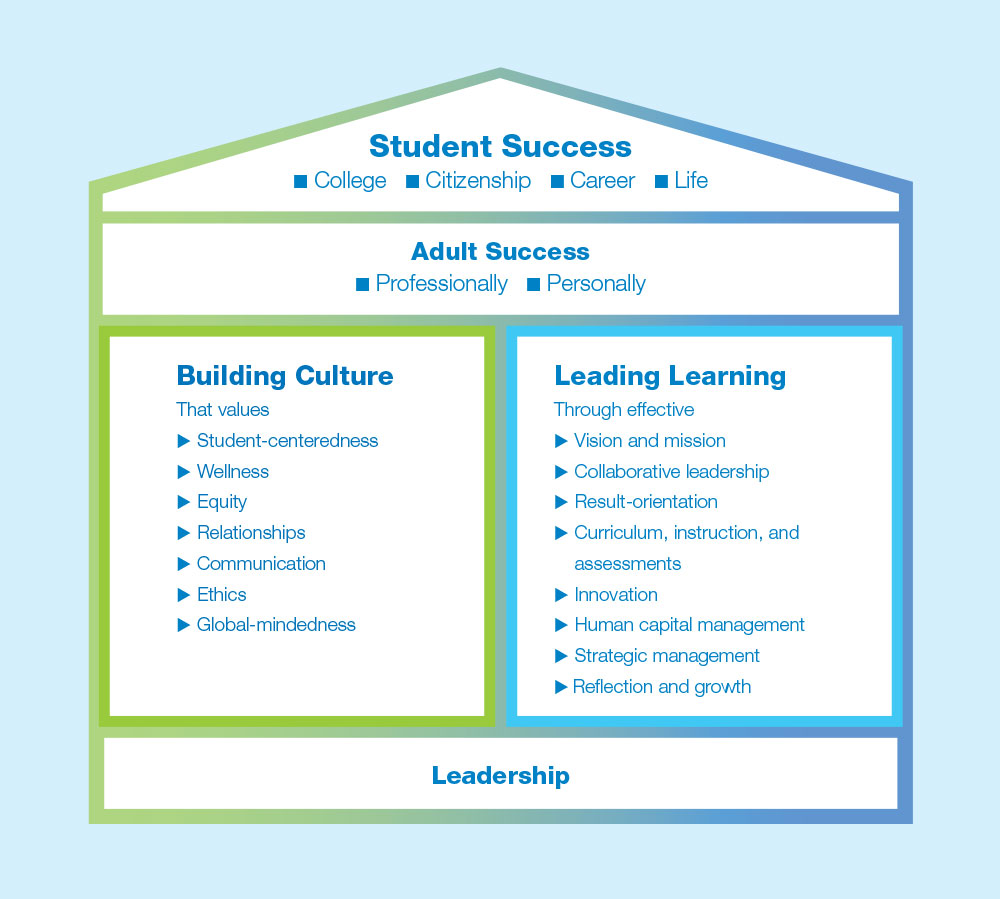Restart and Recovery
BRIEF 2:
WELLBEING AND CONNECTION
Leveraging Principals in Ensuring Wellness and Connection
September 2020

About
Principals, Communicating up is just as important as communicating out. It is critical that your voice is heard, as you are the first recipients of “community feedback”.
The National Association of Secondary School Principals (NASSP) is the leading organization of and voice for principals and other school leaders across the United States. NASSP seeks to transform education through school leadership, recognizing that the fulfillment of each student’s potential relies on great leaders in every school committed to the success of each student. Reflecting its long-standing commitment to student leadership development, NASSP administers the National Honor Society, National Junior Honor Society, National Elementary Honor Society, and National Student Council.

Contents
Strategies for Wellbeing and Connection
Overview
COVID-19 continues to present unprecedented challenges for our schools and communities, with no one-size-fits all road map for districts and their leaders to follow. Following this spring’s extended closure of school buildings and rapid pivot to on-line instruction, the Council of Chief State School Officers (CCSSO) has issued guidance for districts navigating a still-changing public health and education landscape as they move into the 2020-21 school year.
Based on input and best practices from state education agencies and national and local organizations, CCSSO’s guidance recognizes the essential elements of supporting school communities as buildings reopen, including the system-level conditions required for an effective restart, the importance of sustaining strong teaching and learning, and efforts to ensure the physical and mental wellbeing of students, staff, and the entire school community across any combination of remote, in-person, and hybrid scenarios. Research has long affirmed the central role of building leaders in all of these areas, and principals will play a critical role in districts’ efforts to sustain continuity of learning during a period of continued change.

As the voice of school leaders, NASSP is adding to this important knowledge base for districts with three briefs that identify opportunities to ensure that principals both support—and are supported—as part of this essential and intentional work.
Informed by research, national standards, and the practical experience of leaders in the field who have worked extensively with their district leadership on planning and executing reopening plans for Fall 2020, this second brief focuses on strategies districts can explore to leverage school leaders in efforts to support the wellbeing and connection of both students and staff, as well as the delivery of tailored student supports that meet the needs of each student, regardless of background or circumstance.
Strategies for Wellbeing and Connection
Educators, students, families, and communities began the 2020-21 school year facing two unprecedented—and ongoing—crises: the continued disruptions caused by the pandemic and a newfound urgency to drive social change stemming from the nation’s legacy of systemic racial oppression. Districts and their schools have developed strategies and supports to address the wide-ranging physical, social, and emotional needs of their students and staff during a school year that is likely to remain unpredictable as local, public health conditions continue to evolve. Principals will play an essential role in operationalizing these strategies and supports and, through their feedback and advocacy with district leaders, ensuring that they meet the needs of each student while promoting equity and cultural responsiveness across all modes of instruction—remote, hybrid, and in-person.
With wellbeing taking on even greater importance during a period of isolation, stress, and trauma for many students, family, and staff, research affirms the important role principals can—and must—play. Schools whose leaders focus on wellness are more successful at creating effective learning environments, and their students have greater social-emotional control and engage more academically. Principals also play a central role in supporting educators and staff, with research affirming that the school climate they create and guide either improves—or exacerbates—teacher and staff emotional exhaustion, depersonalization, and feelings of low personal accomplishment.
Addressing the nonacademic needs of students and staff—including their overall wellbeing and connectedness to the school community—has become an essential part of the expectations and standards surrounding school leadership. The Professional Standards for Educational Leaders (PSEL) emphasize “the importance of support and care required for students to excel,” and NASSP’s aligned framework for school leadership, Building Ranks, recognizes ensuring the overall wellbeing of students and staff and promoting equity as essential components of a school culture in which each student is capable of reaching his or her full potential. Both PSEL and Building Ranks affirm principals as adaptive leaders who must play key roles as their schools face evolving remote, hybrid, and in-person learning scenarios, and both provide guidance and resources that help school leaders operationalize these leadership practices over time.
Principals must play the pivotal role in creating safe, supportive, and equitable learning environments, regardless of the mode of delivery. They also are essential in elevating student voice and leadership—an element which remains critical in ensuring that remote, hybrid, and in-person learning supports and sustains the wellbeing of all students. And just as principals support the wellbeing and safety of their staff and students, districts must ensure that the wellbeing of school leaders also is supported so they can effectively sustain this vital work.
In the sections that follow, we connect principal expertise and capabilities to addressing wellbeing and connection in the three focus areas identified by CCSSO, as well as identify links to standards and resources that can help school leaders ensure that districts’ efforts around planning and implementation are sustained throughout the school year.
Focus Area Considerations

Staff Wellbeing and Connection
How can we create a culture of care in which staff growth and wellbeing are prioritized, and all feel safe, connected, supported, engaged, and valued, both individually and collectively?
Even in ordinary times, principals play a critical role in supporting the wellbeing of staff—both as professionals who are themselves lifelong learners seeking to improve their practice and as individuals with their own physical, social, and emotional needs that must be met in order for them to effectively support the students they serve. Now, in order for schools to be prepared to meet the growing and complex needs of students across all modes of instruction, principals must play an even larger role in supporting staff growth and wellbeing. As the leaders of professional learning in their schools, they also play a critical role in helping staff develop and implement new approaches to trauma-informed and social and emotional learning (SEL) and anti-racist practices to support students across distance, hybrid, and in-person learning environments.
Like students, many of the adults in school buildings have been impacted by the pandemic and the racial inequities surfaced this year and are navigating their own challenges with stress, adversity, and trauma. Principals are an essential component in school and district efforts to ensure that the needs of all staff are being met through continuous communication, ensuring the viability of ongoing collaborative structures across multiple modalities, and providing referrals to outside resources as needed. School leaders also lead staff by example by being mindful and engaging in self-care and restorative practices themselves—and, importantly, are themselves in need of support by their district leadership and their own structures for collaboration and professional growth. Principal roles in ensuring staff wellbeing and connection include, but are not limited to:
- Introducing, leading, and encouraging ongoing restorative and self-care practices for staff, and leading the use of these practices by personal example.
- Adapting and monitoring existing team structures, including PLCs, grade and subject-level team meetings, and other working groups, to ensure they remain effective in remote and/or hybrid formats.
- Creating opportunities for staff to participate in additional formal and informal opportunities for engagement and collaboration in hybrid and remote-learning scenarios.
- Through check-ins, meetings, and informal practices, providing consistent communication and care about staff wellbeing.
- As needed, referring staff to well-\being, medical, and mental health supports.
- Selecting and leading engagement centered professional development for their staff based on the needs of their specific school populations (trauma-informed communication, SEL, equity, specific language and cultural considerations, etc.)
- Developing and monitoring professional learning plans for each staff member that build their capacity to support student wellbeing and connection across different modalities, along with social and emotional learning (SEL).
- Soliciting and acting upon staff feedback to identify and adapt practices supporting their own wellbeing, as well as engaging staff in identifying professional development and other resources to serve the school community.
- Acknowledging their own need for wellbeing and identifying strategies and supports to ensure their continued ability to support the wellbeing of staff and students.
Supporting Standards and Resources
PSEL Standard 6 charges principals with promoting the personal and professional health, wellbeing, and work-life balance of faculty and staff as a foundational element of building their professional capacity to educate and care for students. Standard 7 emphasizes the value of creating structures that promote the collective responsibility of staff to help meet the academic, social, emotional and physical needs of each student, as well as developing and supporting trusting relationships with and among staff.
NASSP Building Ranks:
The Building Culture Wellness dimension of leadership charges principals with leading the school community to focus on the social, emotional, physical, and safety needs of all members, including staff. It also calls on school leaders to support staff in creating programs or strategies that address the wellness needs of the school community and integrate them into the day-to-day work of the school, regardless of modality.
Resources for School Leaders:
- Reunite, Renew, Thrive: Social and Emotional Learning (SEL) Road Map for Reopening School (CASEL)
- Trauma Informed Schools: Guiding Principles, Recommendations, and Resources (NASSP)
- Self-Care Strategies for Educators During the Corona Virus Crisis (WestEd Center to Improve SEL and School Safety)
- Healing Circles for Teachers as a Restorative Self-Care Practice (Mindful Schools)
- Community Care Strategies for Schools During the Corona Virus Crisis (WestEd Center to Improve SEL and School Safety)
- National Center for School Mental Health (NCSMH) COVID-19 resourcesfor school staff and administrators
- Professional Quality of Life Scale (ProQOL) Survey
- Trauma Sensitive Schools Training Package (National Center for Safe and Supportive Learning Environment, USDOE)
- Leading Success: Programmatic Equity (NASSP)
- Navigating Social and Emotional Learning from the Inside Out (The Harvard Graduate School of Education)
- Advancing Social and Emotional Learning (SEL) as a Lever for Equity and Excellence (CASEL)
- Early Lessons from Schools and Out-of-School Time Programs Implementing Social and Emotional Learning (RAND)
Options for Districts to Consider:
- Develop, provide, and refine ongoing district support and resources for school leaders— both in terms of developing their own capacity to provide support to staff and to ensure that their own physical, social, and emotional needs are being met
- Develop, provide, and refine ongoing training and resources for self-care, restorative practices, and physical and mental health that enable school leaders to provide these supports and professional growth opportunities for their own staff.
- Provide guidance on adapting existing school meeting structures for online and hybrid modalities.
- Allow principals to identify and develop appropriate professional development for their teachers and staff based on the needs of their specific school populations (trauma-informed communication, specific language and cultural considerations, etc.)
- Adapt existing structures for supporting school leaders (such as principal PLCs and/or coaching and supervisory supports) to ensure they remain effective in remote and hybrid environments.
- Model Principal Supervisor Professional Standards 2015 (CCSSO)
Student Wellbeing and Connection
How can we create a culture of care in which student growth and wellbeing are prioritized, and all feel safe, connected, supported, engaged, and valued, both individually and collectively?
Through their efforts to build culture, principals create and sustain learning environments that ensure that students’ physical, social, emotional, and learning needs are met, and that they feel supported and part of a cohesive learning community. This role is even more important as students and schools navigate any combination of in-person, hybrid, and remote learning settings during the 2020-21 school year.
The CCSSO guidance recognizes the important role schools and their leaders must play in addressing trauma experienced by students through equity-focused practices that support learning, healing, and resilience for each student, regardless of background or circumstance. But it also importantly charges school leaders with encouraging staff to focus on students’ newly acquired assets—including emerging skills as independent learners, caregivers at home, and, in many cases, activists and leaders within their community. The guidance uses appropriately strong language about the importance of recognizing and addressing racial oppression, citing research that equates support strategies such as social and emotional learning that don’t explicitly acknowledge these past and present in justices to “white supremacy with a hug.”
An active and engaged student body, including student leadership and a role in decisions about school culture, are crucial components of students’ wellbeing and sense of connection. School leaders play a critical role in ensuring the continuity of student leadership structures and co-curricular activities across changing modes of instruction. Principal roles in supporting student wellbeing and connection include, but are not limited to:
- Adapting and monitoring systems and structures to foster positive student relationships in distance or hybrid learning scenarios, including advisories, morning meetings, family engagement activities, and before/after-school programs.
- Ensuring that each student has a connection with at least one adult in the school who can assess whether their needs are being met.
- Leading and monitoring ongoing family outreach and touch points by school staff, such as shared student-teacher teams or specialized support teams, to understand the changing needs of students and families as conditions and modalities continue to evolve.
- Personally leading or coordinating ongoing outreach to disengaged and difficult-to-reach families to ensure the needs of students with the greatest needs are being met.
- Implementing and monitoring schoolwide systems and structures focused on overall school climate and SEL.
- Reviewing existing policies and data involving school culture and discipline through an equity lens, engaging staff in making any needed changes and challenging assumptions and norms, and monitoring data to ensure they are made in appropriate and equitable ways.
- Establishing and monitoring policies that ensure that supports and relationships are culturally responsive and equitable, and ensuring that staff professional development plans reflect needed changes.
- Leveraging existing relationships with community organizations to support the school’s capacity to support all students and increase practices such as SEL and trauma-informed supports.
- Communicating changes in school policy and available supports to the entire school community.
- Helping school staff adapt and ensure the continuity of student activities and extracurricular activities (including student government, student councils, service and leadership organizations like the National Honor Society and National Junior Honor Society).
- Encouraging staff to foster additional opportunities for peer-to-peer relationships across different modalities.
- Providing avenues for student leadership and voice in school decision-making, including co-creating agendas and action plans and lifting up students as leaders.
Supporting Standards and Resources
PSEL Standard 2 affirms that students are at the center of all education activities and charges principals with supporting their wellbeing, as well as promoting the values of equity, social justice, community, and diversity. Standard 3 places even greater emphasis on ensuring that each student is treated fairly, respectfully, and with an understanding of each student’s culture and context, as well as with respect for their individual strengths. Standard 5 charges school leaders with creating an inclusive community of care and support for students that meets the academic, social, emotional, and physical needs of each student and that ensures that each student is known, accepted, valued, cared for, and encouraged to be an active and responsible member of the school community, in part by leveraging extracurricular activities, academic supports, relationships, and school-community relationships. And Standard 8 stresses the importance of engaging families and the broader community in meaningful ways that support students.
NASSP Building Ranks:
The Building Culture Student-Centeredness dimension of leadership specifically charges school leaders with ensuring that supports are in place for students struggling academically, emotionally, socially, or physically, as well relationships with an adult to ensure their needs are being met. The Building Culture
Wellness dimension emphasizes the importance of integrating these supports into the day-to-day work of the school, regardless of modality. The Equity Leadership dimension focuses on ensuring that each member of the school community is provided fair, just, and individualized opportunities for learning and growth. Additionally, the Communication and Relationships dimensions both recognize the impact on student learning that results from building and sustaining relationships beyond the school building, including with families, community members, and organizations that can help meet the needs of the whole student and their families.

Resources for School Leaders:
- Three Steps for Using Culturally Responsive Practices to Support Equity During Remote Learning (REL Mid-Atlantic/Mathematica)
- Best practices in universal social, emotional, and behavioral screening (School Mental Health Collaborative)
- RISE Index of School Social and Emotional Health (Kaiser Permanente)
- COVID-19 Check-in Survey for Educators (Harvard School of Education)
- Building Developmental Relationships During the COVID-19 Crisis (Search Institute)
- Mental Health in Middle Level and High Schools: Guiding Principles, Recommendations, and Resources (NASSP)
- National Student Council (NatStuCo) COVID-19 resources for student councils and governments
- National Honor Society/National Junior Honor Society COVID-19 resources for chapter management
- Advancing Social and Emotional Learning (SEL) as a Lever for Equity and Excellence (CASEL)
- Effects of Extracurricular Participation During Middle School on Academic Motivation and Achievement at Grade 9 (2016) Am Educ Res J. 2016 ; 53(5): 1343–1375.
- How Youth Can Help Communities (YSA)
- COVID-19 and Back to School Resources (Alliance for a Healthier Generation)
- Leading Success: Equitable School Culture (NAASP)
- Navigating Social and Emotional Learning from the Inside Out (The Harvard Graduate School of Education)
- Early Lessons from Schools and Out-of-School Time Programs Implementing Social and Emotional Learning (RAND)
Options for Districts to Consider:
- Provide guidance and resources to sustain existing school structures such as advisories and family engagement activities that foster positive student relationships in remote or hybrid scenarios.
- Support school leaders in developing and monitoring specialized support teams to focus on the needs of students and families in remote and hybrid scenarios.
- Reinforce and support principals as the voice of parent and community outreach for their schools.
- Review and revise existing district-wide policies involving school culture and discipline and empower principals to lead conversations about revisiting written and unwritten policies, norms, and expectations within their own buildings.
- Affirm the importance of student voice and leadership in school and district-level decision-making.
- Provide resources, including funding, to allow school leaders to sustain and adapt extracurricular activities and student leadership groups. A key district role is working with local, state, and national organizations and community leaders to develop appropriate guidance and timelines to restart and sustain programs and services.
- Model Principal Supervisor Professional Standards 2015 (CCSSO)
Tailored Student Supports
How can we identify the range of health and wellbeing needs of our students, and provide them with or connect them to effective, culturally relevant supports?

Given their existing relationships and deep understanding of individual needs within each school community, principals are the primary lever by which districts can ensure that supports are tailored and delivered in equitable and ethical ways that meet the needs of each student. Principals can—and must—leverage existing relationships with families and the community resources that can help schools and districts support their most vulnerable populations. They also play a critical role in creating and monitoring the data-driven cycles of inquiry and improvement that leverage feedback from the entire school community to ensure that the needs of each student are being met in effective and equitable ways, regardless of their background or circumstances. Principal roles in providing tailored student supports include, but are not limited to:
- Creating and monitoring systems to screen students for tailored supports to accommodate changes during the school year and/or when learning modalities shift.
- Supporting a multi-tiered system of supports that build on existing supports for all students described in the section above with targeted interventions.
- Ensuring that ongoing communications with families provide information and feedback on the efficacy of supports as conditions and modalities continue to evolve.
- Identifying and leading partnerships with community organizations and other external resources that increase the school’s capacity to provide tailored student supports, as well as monitoring efforts to ensure they are implemented effectively and equitably, and establishing and maintaining communication channels with these organizations, including data-sharing agreements.
- Establishing and monitoring data driven cycles of inquiry that ensure that supports address the needs of all students, using disaggregated data to capture the experiences of students regardless of race, ethnicity, socioeconomic level, gender identity, sexual orientation, or status (EL, immigration, ability).
- Adjusting supports and interventions based on gaps surfaced by data and feedback from students, families, and community organizations/providers.
- Including student and family voice, feedback, and input in data and planning decisions for supports and other culture.
Supporting Standards and Resources:

As part of creating a community of care and support for all students, PSEL Standard 5 specifically charges principals with creating coherent systems of academic and social supports and accommodations to meet the range of learning needs of each student. Standards 9 and 10 both emphasize the importance of monitoring operations and developing and maintaining data and communication systems that deliver actionable information for improvement.
NASSP Building Ranks:
As with ensuring the overall wellbeing of students, the Student-Centeredness and Wellness dimensions of Building Culture specifically charge school leaders with ensuring that individualized supports are in place for each student struggling academically, emotionally, socially, or physically. Creating the feedback systems and improvement cycles to ensure that these processes are effective is connected to a wide range of other leadership dimensions, including Human Capital Management, Strategic Management, and Results Orientation, which call for strategies that maximize organizational performance based on changing needs.
Tools and Resources for School Leaders:
- Mental Health Toolkit: Provide Multiple Tiers of Support (Transcend Education)
- School Mental Health Quality Guide: Screening (SHAPE)
- Leading Success: Using Data to Assess and Inform School Change (NASSP)
- Advancing Social and Emotional Learning (SEL) as a Lever for Equity and Excellence (CASEL)
- Navigating Social and Emotional Learning from the Inside Out (The Harvard Graduate School of Education)
- Early Lessons from Schools and Out-of-School Time Programs Implementing Social and Emotional Learning (RAND)
Options for Districts to Consider:
- Develop and provide guidance to school leaders on modifications of formal targeted interventions and systems (such as Tier 2 and 3 supports) for remote and hybrid learning models.
- Empower school leaders to leverage existing school-level relationships with community partners and organizations to meet student and family needs.
- Leverage principals as local points of contact and decision makers for district-wide partnerships with large community organizations and service providers to ensure that third-party supports effectively and equitably meet the needs of individual students.
- Develop and expand differentiated data systems and reporting to assist school leaders in overseeing cycles of inquiry on efficacy of supports across a wide range of student characteristics.
- Model Principal Supervisor Professional Standards 2015 (CCSSO)

Conclusion
Wellbeing and connection are, by their very nature, highly personal and varied from person to person. The lens by which schools and districts can act on these vital factors that shape learning is an individual one, and school leaders have the greatest ability to ensure that the needs of all students and staff are met during this challenging school year.
Principals are expected to deeply know and understand the needs of their entire school communities—and the children, families, staff, and community organizations which comprise them. They see the challenges their students and staff have faced since the rapid transition to remote learning in the spring—but also the ways in which they have grown as educators and learners, as family and community members, and as leaders and activists.
This highly personal lens offers districts an avenue by which to ensure that strategies intended to address the challenges of multiple learning modalities, increasing stressors of family and staff relationships, and the call to address inequities in our schools and our society are effective not just for some or most students, but each student. Importantly, principals also provide an authentic avenue to bring student voice and leadership to bear on decisions in more meaningful ways, which is all the more important at a time when many young people are becoming activists committed to righting past inequities and improving their communities.
It is our hope that this document and the others in this series will help district leaders continue to enhance opportunities for building leaders to support their staff, students, families, and communities as they and their schools navigate a challenging and unpredictable school year. We also hope that it will assist districts in modeling the strategies they want to see from their school leaders through their own understanding of principals’ individual needs and support for their wellbeing.
The CCSSO guidelines notably—and rightly—base what will make a district’s efforts a success during this challenging year on their ability to equitably serve each student, including those with the greatest needs. School leaders’ deep understanding of their students, staff, and the communities they serve provide the strongest opportunity to ensure that this vital goal is met.
Nassp Leadership Framework—Building Ranks
Your Guide to Effective School Leadership

Building Ranks: A Comprehensive Framework for Effective School Leaders contains materials and guidance that focuses leadership efforts on Building Culture and Leading Learning, the two domains of successful educational leadership. Reflection exercises and tools to promote it are integrated throughout the guide, with invaluable case studies from real principals. Devoid of jargon and packaged in a readable format, this book offers myriad possibilities for common reads in administrative groups, book studies, and more. To learn more, visit www.nassp.org/professional-learning/building-ranks/.

For more information
Dr. Beverly J. Hutton
Deputy Executive Director
[email protected]
